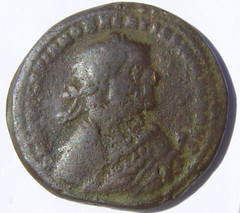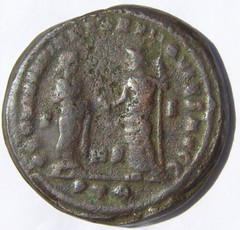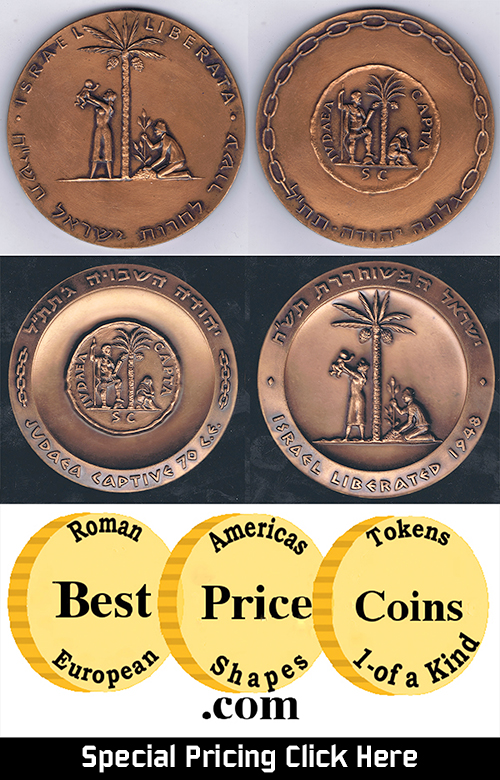
PREV ARTICLE
NEXT ARTICLE
FULL ISSUE
PREV FULL ISSUE
MYSTERY COIN: DIOCLETIAN ABDICATION NUMMUS
Readers have come though with an attribution for Phil Hoover's mystery Roman coin, found while metal detecting in Seattle WA.
-Editor


Paul Schultz of Pennsylvania writes: I have a reasonble guess at that Washington State coin. In my old, single volume book by Sear, Roman Coins and their Values, it may be 3543, a Roman follis from soon after 305 AD. This is a Diocletian issue after his abdication. The lettering isn't very clear due to corrosion, but I think the portions of the obverse I can read (after staring at it for a half hour) correspond well to that coin: D N DIOCLETIANO FELICISSIMO SEN AVG, and the letter count is about right. The reverse correlates well with: PROVIDENTIA DEORVM QUIES AVGG. The mint mark in the exergue is PTR, definitely the Trier (Germany) mintmark. Roman Imperial COins Vol 6 p208 has several variants. It is not nearly as common as the Constantine Aes that sell for several dollars each, but is still not at all rare. My first guess is that a collector lost it recently since most verdigris is removed leaving a porous surface. Since it is not rare and the condition is much less than ideal, perhaps a child lost it coming home from a coin show with Dad. Hugh Cloke writes: I think your reader's mystery coin is an abdication nummus of Diocletian struck at the Roman mint at Cyzicus. The coin commemorates Diocletian's retirement in AD 305 The obverse legend reads D N DIOCLETIANO BAEATISSIMO SEN AVG, surrounding a bust of Diocletian wearing an imperial mantle, holding an olive branch in his right hand and a mappa in his left. The reverse legend reads PROVIDENTIA DEORVM QVIES AVGG, surrounding images of Providentia, standing right, extending her right hand to Quies who is facing left, holding an olive branch in her right hand, while her left hand is leaning on a sceptre. The letters S-F appear on either side of the two figures. The mint mark is Kζ; PTR. The coin is cataloged in RIC VI as 678 for Trier, although more recent scholarship attributes this type to Cyzicus where, it is suggested, dies prepared at Trier were copied by the engravers at Cyzicus who combined the PTR mint mark the Cyzics mark in the field between the figures of Providentia and Quies. Best wishes,
Hugh Cloke
Paul adds: I looked carefully, and I am inclined to agree with BAEATISSIMO rather than FELICISSIMO. This makes it something of a hybrid between the old Sear (single volume) 3543 and 3542, which is not unusual since the Sear book contained representative examples, not every minor variation. This changes the obverse translation to something like Our Lord Diocletian Very Blessed Senior Emperor. The obverse inscription compared to pages 206- 208 of RIC 6 now correlates with their 6b rather than 6c variant. Regarding the mint, Hugh is saying that the mint in Cyzicus (now in Turkey), copied Trier (Germany) dies including the Trier mint mark, and then added their own mint mark too, quite an oddity. All of my references call the denomination a follis, not a nummus, which I thought came later in Byzantine times. I agree now with BAEATISSIMO. He is clearly more up to date than I am so I would concede that Cyzicus is more likely the real mint despite the Trier mint mark, with an interesting story behind those mint marks. Hugh writes: Nummus is the preferred term for these coins in modern scholarship. The term follis, which is found in most if not all older reference books such as Sear, actually refers to a bag of coins. We do not know how the Roman referred to these coins. For a discussion of the terms see: http://www.forumancientcoins.com/board/index.php?topic=78859.0 .
Thanks. I was planning to translate all of this into more accessible layman's terms, when Paul came back with just that.
-Editor
Paul writes: It is, of course, an ancient Roman coin, which I really did not explicitly state in the description. The bust of the Emperor shows him facing right, Laureate (wearing a wreath or laurels), holding a branch and mappa (mappa definition from David Sear site: originally the white napkin dropped by an emperor or magistrate as a starting signal at the Circus, in late Roman iconography it came to be a used as one of the principal attributes of the consuls, (therefore in this case showing that Diocletian also held the office of Consul)). The reverse shows Quies and Providentia facing each other. Although the coin is not especially scarce, the inclusion of Quies, the personification of Quiet or tranquility is rather rare on any of the Roman coins. Pax would be much more typical, the personification of Peace. Providentia is the personification of foresight. The inscriptions on both sides are unusually long for a Roman coin with a Latin inscription (but local coinage in Greek from the eastern areas of the empire are more often this long). My Latin vocabulary is rather poor beyond that used in typical coin inscriptions, and my Latin grammar is horrible. The reverse proclaims something like the Providence of the Gods, The Quiet/Tranquility of (implying provided by) the Emperors. Anyone wishing to correct this is likely right. I wouldn't be surprised to find it for sale at an ancient coin dealer for $10-$40. The Roman Empire had mints all over the Roman world, and Treverorum (now Trier, Germany) was a fairly important one. PTR stands for the Treverorum mint, first office or section (P for Prima). The reference to RIC means Roman Imperial Coinage, an 11 volume set of books on Roman coins that took several authors over 50 years to write. There is a more recent version of Roman Coins and their Values than the single volume version I cited, a new set of 5 volumes, but a beginner may wish to start with the less expensive and less voluminous 1988 single volume version. We are talking about emperors, plural, because Diocletion found that it was very difficult for a single person to rule the vast Roman Empire, so he devised a system in which there were 2 senior emperors and 2 junior emperors, dividing the work between them. Standard references on Roman emperors or Diocletian will explain this in much greater detail. Another possibility occurs to me for the coin's presence in Washington, that is someone may have planted it intentionally where metal detectorists might search. It could have been a joke, or someone trolling in hope the finder thinks this is proof that ancient aliens sent Romans to the Pacific Northwest, or even a coin collector trying to interest a metal detectorist in something very different from 19th and 20th century US coins. If the latter, I hope he succeeds.
Thanks, everyone. Great attributions and explanation.
-Editor
To read the earlier E-Sylum article, see:

Wayne Homren, Editor The Numismatic Bibliomania Society is a non-profit organization promoting numismatic literature. See our web site at coinbooks.org. To submit items for publication in The E-Sylum, write to the Editor at this address: whomren@gmail.com To subscribe go to: https://my.binhost.com/lists/listinfo/esylum All Rights Reserved. NBS Home Page Contact the NBS webmaster 
|